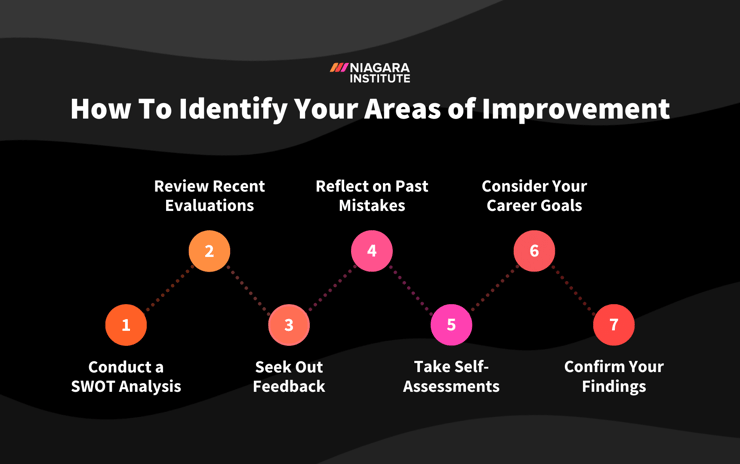4 min read
Is It Good to Be a Multitasker? Researchers Say the Answer Is No
Do you feel an unspoken pressure to be good at multitasking at work? Have you been told over the years by your bosses, colleagues, and even the...
3 min read
 Michelle Bennett
:
May 4, 2023 5:00:00 AM
Michelle Bennett
:
May 4, 2023 5:00:00 AM

You know that everyone has their faults, weaknesses, and areas of improvement at work. However, you also know that perfection is impossible to achieve and that holding yourself to that standard only leads to disappointment and demotivation.
Yet, when you’re faced with these things, especially when speaking to someone in a position of authority, do you find yourself trying to avoid, downplay, or deny them? While that’s a normal reaction, it’s not ideal.
What if, instead, you owned up to your areas of improvement at work? What if you said, “I know I’m not great at this. But it’s something I’m aware of and actively working on. Here’s exactly how I’m doing that.”
If you think about it, that has the potential to be a compelling and impressive statement. It shows self-awareness, initiative, integrity, and humility, which are highly admirable and sought-after traits in today’s workplace.
In the following article, you will learn how to identify your areas of improvement at work so that you can begin the journey toward improvement with confidence.

 One way to begin identifying your areas of improvement is to conduct a personal SWOT analysis. It’s a relatively simple exercise. All you need to do is simply answer a series of questions regarding your strengths, weaknesses, opportunities, and threats to success.
One way to begin identifying your areas of improvement is to conduct a personal SWOT analysis. It’s a relatively simple exercise. All you need to do is simply answer a series of questions regarding your strengths, weaknesses, opportunities, and threats to success.
The key to conducting an effective personal SWOT analysis is to answer the questions as honestly as possible. If there’s a question you would rather not admit the answer to, then there’s a good chance it’s an area of improvement you need to make a note of and explore deeper. To help you get started, use this personal SWOT analysis template.
Depending on your leader’s and company’s approach to performance management, you may have access to your past performance reviews or notes from performance conversations. If you do, collect the most recent copies and review them. You’re looking for commonalities and themes.
For example, are there areas you have repeatedly scored below average on? Is there a weakness or area of improvement your direct supervisor seems to hit on every time? If there is, you’ll want to note the area of improvement and cross-reference it with all the other information you find from the sources listed in this article.
Besides self-reflection, one of the best ways to identify your areas of improvement at work is to seek out constructive feedback from those you work with. Start with your direct supervisor and the members of your intact team. They are the ones who will have seen you at your best and your worst, so they are often the best source of insightful feedback. You can also ask for feedback from your mentor or a colleague/leader from another department who you regularly have to collaborate with.
Once you have a sufficient amount of feedback, begin to look for commonalities, themes, and patterns. If there are things that different people repeatedly mention, that’s something you will want to pay particular attention to and make a note of to improve.
As much as you may not want to, it is worthwhile to think back on instances in the recent past where you encountered a challenging situation or made a mistake. Ask yourself, was there something it would have been beneficial to have in that situation that would have allowed you to handle things differently? This exercise will help you identify if something needs to be done, such as acquiring knowledge, learning a skill, or attending training. If so, consider that an area of improvement and include it in your plan going forward.
In addition to self-reflection and feedback, take a few self-assessments as you work to identify your areas of improvement at work. These are great because they often ask questions you may not have otherwise or cause you to think about things in a new light. While there are countless self-assessments available that you can pay for if that’s not in your budget, here are a few free self-assessment alternatives:
Do you have a career plan or professional vision for yourself? If you do, there will be areas of improvement that you need to identify now and begin working on for those plans and goals to become a reality. These areas are in addition to the more general areas of improvement that influence your success regardless of your title, the department you work in, or the company you work for.
Once you have a good idea of your areas of improvement at work, ask someone you trust, like a coworker, mentor, or friend, to discuss your findings. Not only will they be able to tell you if you are too hard on yourself, but they may also be able to identify areas you may have overlooked during the process. Doing so will make you feel more confident as you move on to setting development goals and creating an improvement plan.
.png)
4 min read
Do you feel an unspoken pressure to be good at multitasking at work? Have you been told over the years by your bosses, colleagues, and even the...

6 min read
Every leader is unique, from their leadership style to their personality type and preferences. That’s why it can be hard to know what to say or do to...
.png)
7 min read
Professional goals should give you something to work towards and look forward to. They provide a sense of purpose, ownership, and pride when they're...